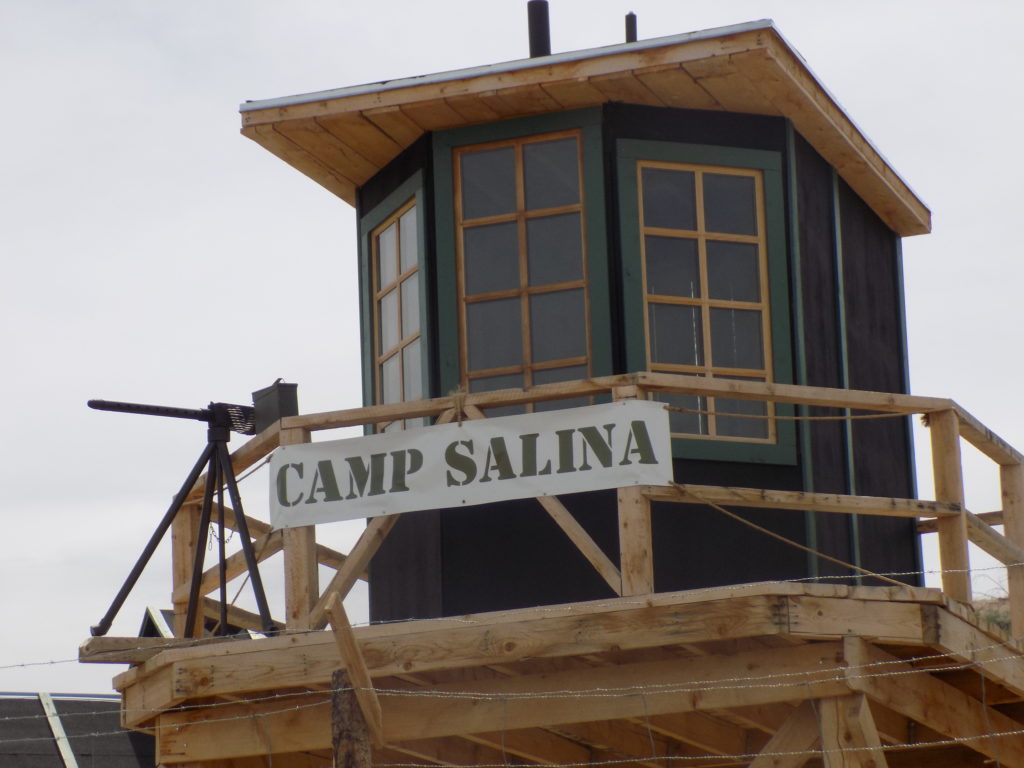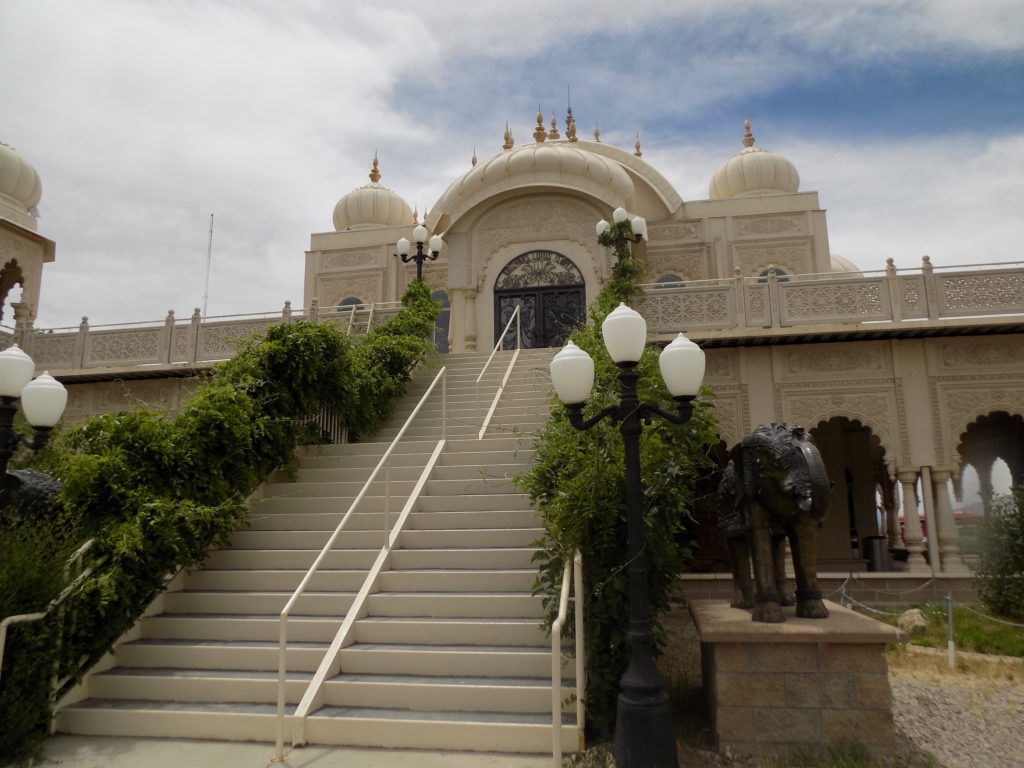Next stop, Salina. The site of a little known massacre.
The next bit of history isn’t at all whimsical. It’s about a massacre in Salina, Utah that didn’t involve settlers or Indians. It happened on 8 July 1945. The perpetrator was an American soldier. The victims were nine German prisoners of war.
The first American troops to take part in the European theater in World War II arrived the United Kingdom in late January 1942. Did you ever consider what happened to enemy soldiers captured by American troops in battle? Well, nearly 425,000 of them – 371,000 Germans, 50,000 Italians and 4,000 Japanese – were transported to the United States and held in camps that could be found in 44 of the then 48 states. Only Vermont, Nevada and the Dakotas – North and South – didn’t have at least one documented P O W camp.
It’s hard to pin down a precise number for the camps but, including Branch and Area Camps the total appears to have been close to 700. The site gentracer.org lists 10 camps in Utah but, although it has a link to a site with information about the Salina Massacre, the camp itself isn’t on its list. The Wikipedia list of U S prisoner of war camps includes the camp at Salina but notes only two others in the state.
Throughout the war, approximately 15,000 prisoners were held in camps in Utah. About 8,000 were German and most of the rest were Italian. The camp at Salina was considered a branch camp of the larger site at Fort Douglas in Salt Lake City. Salina housed around 250 German prisoners beginning in 1944.
The camp had originally been built in 1933 or 1934 to house workers in the Civilian Conservation Corps or CCC. (As part of his plan to lift the U S out of the depths of the Great Depression, President Franklin D Roosevelt established the CCC with Executive Order 6101 which he signed on 5 April 1933. The first of Utah’s 116 CCC Camps – of which between 30 and 35 operated at any given time – opened in early 1934. CCC projects varied according to community need. Employees built campgrounds, worked on erosion control, fought forest fires, planted trees and, in the case of the Salina camp, aided farmers with planting and harvesting. By 1942, most of the CCC camps, including the one at Salina, had been shuttered or abandoned.)
Three guard towers were built when the camp was reconstituted as a P O W camp in 1944 and the 250 German prisoners housed there were engaged as unpaid labor in the same tasks of planting and harvesting as their CCC predecessors.
This summarizes the story of the massacre as reported in several sources:
On the night of 7 July 1945 Private Clarence Betrucci went into town and spent the night drinking. Before reporting back to the camp where he was slated to take guard duty at midnight, he stopped in a café on Main Street. He’s reported to have drunk some coffee and to have told a waitress that something important was going to happen at the camp that night.
He climbed the guard tower nearest the officer’s quarters and loaded a belt of ammunition into the .30 caliber M 1917 Browning machine gun mounted there. Shortly after midnight, he methodically opened fire on the tents housing the German soldiers and in less than 30 seconds exhausted all 250 rounds of ammunition in the belt before he surrendered to responding soldiers.
Six of the prisoners died at the site and 23 were injured. Of the injured, three more failed to survive the night making this incident the worst massacre of Germans on U S soil in World War II. Those who died were buried with full military honors (absent the Nazi flag) at the Fort Douglas Cemetery in Salt Lake City though the circumstances of their deaths went unreported for some time afterward.
This would have been both criminal and tragic under any circumstances but I urge you to look again at the date – 8 July 1945. This was two months to the day after Germany surrendered unconditionally on 8 May 1945. The young men aged 18 to 24 who were murdered in the dark of night had been picking beets in the morning. That night they were simply waiting to be transported home.
The camp fell into disrepair for decades as did a memorial in Fort Douglas Cemetery to German soldiers who had died in Utah during both World Wars. In 1988, the memorial was repaired with funds from the German Air Force. The Salina camp was restored and opened as a museum (with very limited hours) on 12 November 2016.
Hare Krishna, Hare Krishna, Krishna Krishna, Hare Hare.
If you search for Spanish Fork, Utah on a map, you’ll find it about 10 miles south of Provo and another 45 miles south of Salt Lake City. I don’t know about you but, given its location, it’s among the last places I’d expect to see this.
If I asked you to name the first trait that comes to mind about the population of Utah, what would your answer be? I’ll go out on a limb and guess you’d associate them with the Church of Jesus Christ of Latter Day Saints (Mormon). And that would make sense. It’s the only state where that religion constitutes a majority of the population.
In fact, according to the Pew Research Center, of adults over age 18, more than half the state’s population – 55 percent, identify as Mormon. That’s by far the highest percentage of any state. The LDS Church in Utah has more than 2,000,000 members. The nine states with the next highest percentages of Mormons in their population have a total of 1,680,000 members.
(I was surprised to read that the next largest bloc of Utahns, 22 percent, described themselves as “religious nones”. Nearly seven in ten called themselves “nothing in particular” while citing religion as unimportant. Only three percent claimed to be atheists. Fewer than one percent of Utahns call themselves Hindu.)
Now, I have only a passing idea of the number of Hindu temples in the United States (the Wikipedia “List of Hindu Temples” page has about 900). Of these, only a small subset would be representative of the International Society for Krishna Consciousness (ISKCON). The Sri Sri Radha Krishna Temple in Spanish Fork is a part of the Krishna movement.
Unlike what you might have come to expect, I’m not going to provide a treatise about the various Hindu denominations or even its four major traditions. However, I hope you’d be as curious as I to learn how and why someone chose to build a Krishna Temple in sparsely populated but densely Mormon Utah. Here’s what I discovered.
In 1966, Abhay Charanaravinda Bhaktivedanta Swami Prabhupada (ACB) came to New York from India and founded the movement of global missionary Vaishnavism under the auspices of ISKCON. Among the early American followers of this movement was a man named Christopher Warden who, as a Hindu convert, eventually became Charu Das. Warden left the U S to avoid the Vietnam War. He met and married his wife in Singapore and the pair then moved to Australia where they discovered Krishna Consciousness and spent an unspecified number of years proselytizing before they returned to the United States. Warden had now become Charu.
In 1975, Charu traveled to Utah for the first time under a trust to sell books for ISKCON at Brigham Young University. Though he spent only a short time there before moving to California where he produced a purchased time radio show, he left Provo impressed by the tolerance and amity of the people he’d encountered.
Charu liked the idea of using radio to spread the word of Krishna and, in the early 80’s he saw an ad offering the sale of a 1,000 watt AM radio station near Provo. In 1982, he purchased not only the radio station but the five and a half acres of land that the station owned. Thus, a temple site was born.
The people at the temple are open and inviting and visitors are free to wander the grounds and visit the upper temple room (as long as they remove their shoes for the latter). Visitors can also have a meal at Govinda’s Buffet that offers an assortment of vegetable soups, curries, dahl, papadum and salad. The Krishna diet is strictly vegetarian which is also a bit incongruous for Utah.
Govinda’s is open from 11:00 to 19:00 and twice a day freshly prepared food is taken from the serving area and offered to Krishna. It’s then returned to the buffet but, according to Krishna belief, its nature has changed from being bhog (physical food only) to being prasadam (blessed food). Further, in its new state the food is now said to fill not only the body but, regardless of the diner’s beliefs, to fill and uplift the soul as well. And all this for just five dollars.

